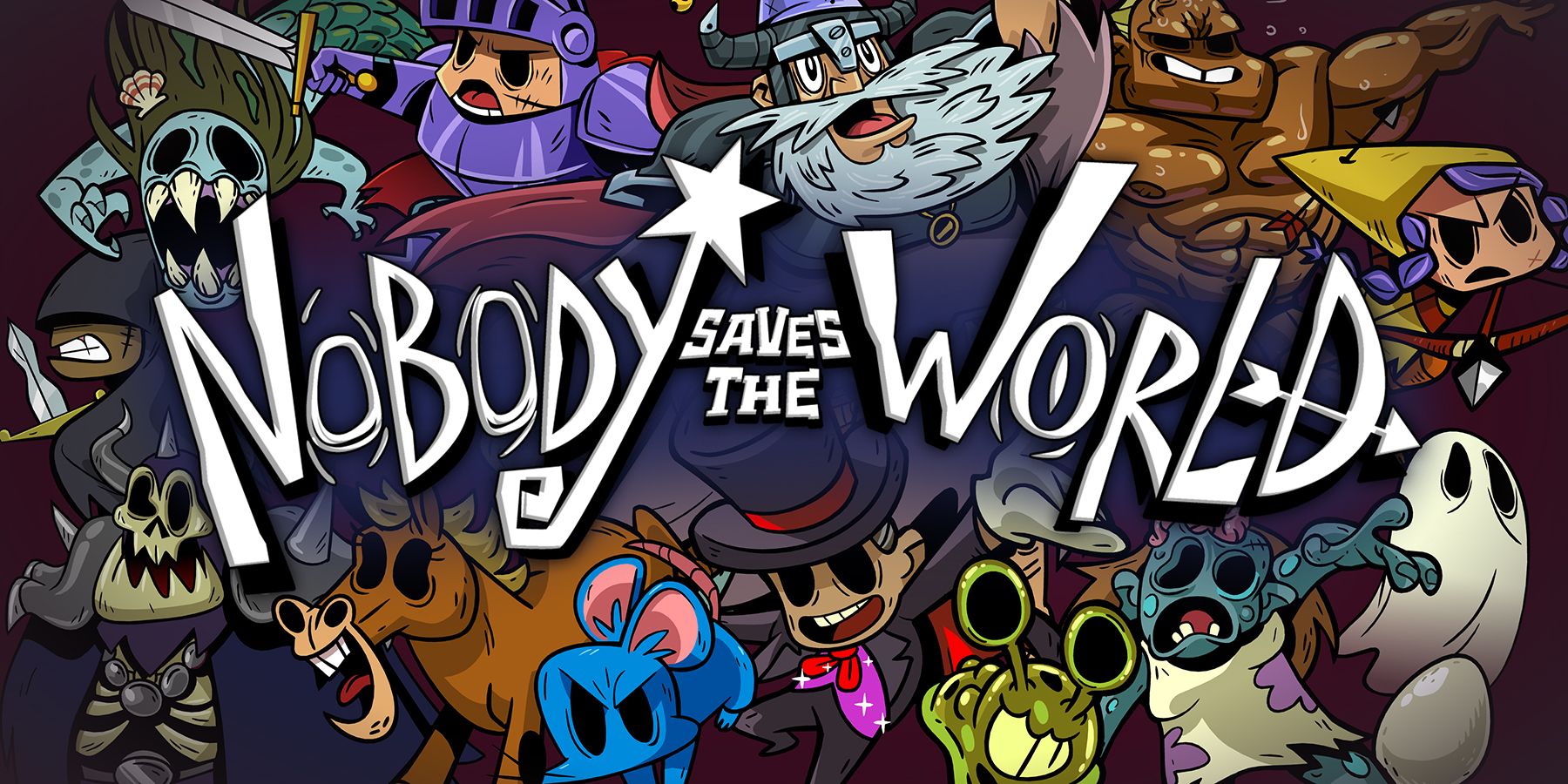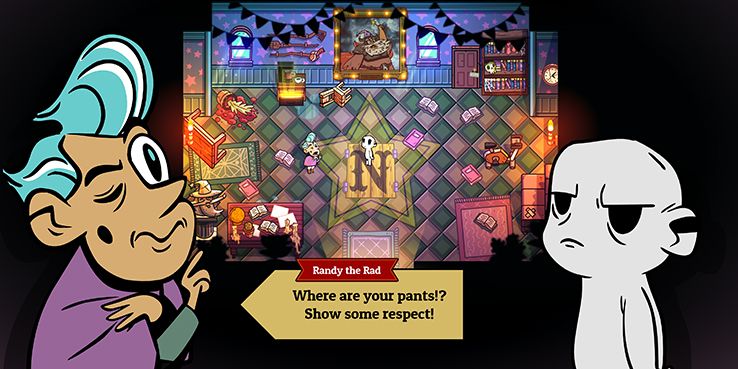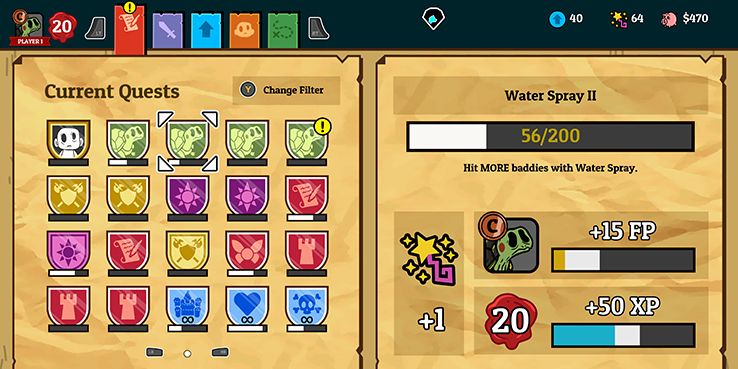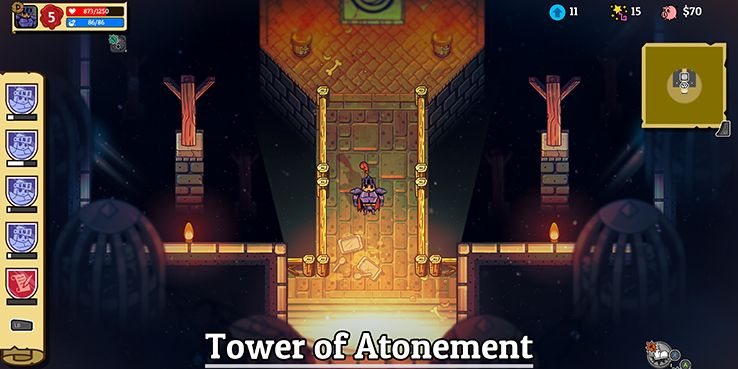In 2014, Drinkbox Studios released a zany action platformer called Guacamelee that quickly earned the praise of critics and players alike. This was followed by an equally humorous sequel in 2018, and fans have been eager to see what the developer offers next. Taking a break from platformers, Drinkbox’s latest creation Nobody Saves the World is a dungeon crawling RPG that delivers some of the humor that gamers expect and tosses in a slight re-skin of long-established classic RPG tropes.
When most people think of an RPG, certain elements immediately come to mind like magic, armor, swords, goblins, and of course a fantasy setting. An RPG that breaks from this standard formula automatically feels innovative and, in the case of Nobody Saves the World, this is somewhat true. Yet despite the general impression that the game is avoiding dusty RPG tropes, it isn’t an overarching divergence. Even the title Nobody Saves the World advertises that the game is in fact based on one of the most pervasive and overused themes in RPGs.
Players begin the game as a featureless nobody with nothing — no name, no memory, and no clothes. Yet somehow this ghostly pale amnesiac obtains a magic wand and is soon working his way through a checklist of quests. His objective? To save the world, of course. A growing dark force called the Calamity has returned to corrupt the land. The superstar magicians who would normally be called upon for assistance have disappeared, and for some reason, Nobody is the sole backup plan. That’s about as far as it goes. The story of Nobody Saves the World seems like a cookie-cutter outline slapped on because it was necessary.
Nobody won’t remain a nobody forever, though. Thanks to the magical wand that he borrowed without permission, the game’s hero gains the ability to shapeshift into all manner of useful creatures. And herein lies the selling point of Nobody Saves the World. The different characters, or forms, each have strengths, weaknesses, and unique abilities. The slug leaves a trail of slime that slows enemies, the turtle retreats into its shell and slams into foes to knock them back, and the ranger uses poison-tipped arrows to deal debilitating damage over time.
Discovering these abilities and learning to juggle them as needed is part of the fun, and each character’s skills intuitively complement the others. The rat gnaws on enemies to gain mana, then spends that mana to consume foes, dealing massive damage and restoring its health. The ability that slows enemies simultaneously gives the snail a speed boost, allowing it to zip away and shoot tears from its googly eyes from a safe distance. At first, it seems that the large selection of characters might be limiting, forcing players to use forms they don’t like just to gain access to a useful skill or two. But once a skill is unlocked, it can be equipped by any form, and this opens up interesting avenues for mixing, matching, and building a character suited to individual play styles.
Unfortunately, the number of unlockable characters is a negative for a different reason. In Nobody Saves the World, experience is earned exclusively by completing quests and not by killing monsters. Yet the majority of the quests in the game are repetitive and unfulfilling busy work. For every new skill learned by each character, the player must complete a series of monotonous tasks. For example, the game will ask the player to kill 100 enemies with the turtle’s water spray, then kill 200, and then kill three enemies at once 25 times. The pattern repeats with most attacks in the game.
But it goes beyond even that. Because characters can use each other's abilities, there are also quests to defeat enemies using other characters’ skills. This gets redundant very quickly, and there is no attempt to disguise how recycled the quests are. Unapologetically, there are even three quests that can be completed over and over. Of course, the game also offers more ordinary quests like fetching a potion to cure a curse, rescuing a knight from a dungeon, or collecting chocolate for a witch, and these provide a welcome and sometimes entertaining break from the monotony.
This repetitiveness even extends to the items that are available for purchase from vendors. Other than a few bonus skills, all that’s for sale are different levels of the same six items. There are physical attack and defense upgrades, magical attack and defense upgrades, and a constantly renewing supply of dungeon keys and skill upgrade tokens. This makes a basic element of RPGs, collecting currency by defeating enemies, slightly unsatisfying because it’s only used to purchase the same things over and over.
The dungeons in Nobody Saves the World are procedurally generated. This presumably means that every excursion into the depths should feel at least a little like embarking on a new adventure, but that isn’t the case. Playing through the same dungeon more than once or twice — which is necessary to complete quests, level up, and unlock characters — very quickly begins to feel same-y. The variations introduced by the procedural generation don’t sufficiently alter the dungeons, and each playthrough feels just like all the others. The encounters are the same, the general layout is the same, and the ending is the same. In fact, all the dungeons are completed in an identical manner, making the finales very easy to identify and removing the sense of discovery.
The variety of dungeons, on the other hand, is enough to keep people moving forward. Players will explore a witch’s candy house, climb a tower of atonement, investigate a UFO, and venture into the belly of a whale. Stepping into a new dungeon for the first time is always a bit exciting, like unwrapping a present, and many of the dungeons have special parameters that add to the challenge. In the Witch Queen Catacombs, for example, restorative items heal both the player and enemies. Foes within the whale dungeon have rocket retaliation, and the Big Gnarly dungeon has the intimidating proviso of “All Damage x9999.”
Another strength of Nobody Saves the World, the graphics, can’t be overlooked. The polished, colorful, and detailed art style is very appealing and adds personality to the game. The presentation is lighthearted and cheerful and, like the dungeons, the world’s environments are varied enough to make exploration rewarding.
Overall, Nobody Saves the World could have been exceptional, but there are certain aspects that are lacking. The expected Drinkbox Studios humor isn’t pervasive enough to keep people playing to see what’s next, the story is negligible and seems like something tossed in to give players a half-hearted sense of purpose, and the repetitiveness of quests gets tiresome very quickly. The positives of the game – the appealing art style, variety of skills and dungeons, and perhaps multiplayer — might not be enough to keep players interested either. That being said, the gameplay and presentation of Nobody Saves the World will undoubtedly win over many people, and it may capture the attention of others for a solid chunk of time.
Nobody Save the World is available on PC, Xbox One, and Xbox Series X/S. Game Rant was provided an Xbox code for this review.





